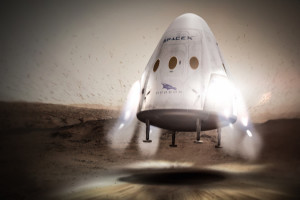Artist’s conception of the Red Dragon spacecraft landing on Mars. Credit: SpaceX
If you’ve kept your eyes peeled, you’ve noticed history in the making. A private individual has announced a Mars plan that’s more realistic and more likely to happen in the near future than any planetary settlement plan that any of the 70 space agencies on planet earth have conceived. The first step? Elon Musk has said that he will put a spacecraft, a SpaceX Red Dragon capsule, on Mars as early as 2018.
Here are a few facts about this Mars venture that may have slipped by without notice:
- The Red Dragon can land two to four metric tons on Mars. This is more than all the rovers that have been landed on Mars combined (Curiosity, Spirit, Opportunity and Sojourner).
- This may be the first time since 1606’s Plymouth Company that a private firm has planned such an audacious feat on its own dime.
- Previously, space missions like the Red Dragon have been attempted by governments, and by governments only. Why? Landing on Mars is hard, and NASA has been the only organization to fully succeed with this feat. Most Russian attempts to land on Mars have been total failures. The Russians did succeed in soft landing the Mars 3 spacecraft on Mars in 1971, but this spacecraft only survived for 14.5 seconds after landing before transmissions ceased. The European Space Agency tried but failed to land the Beagle 2 spacecraft on Mars in 2003.
- Why is SpaceX pursuing this mission with no funding from NASA? SpaceX has ambitions that dwarf Red Dragon. The Red Dragon mission is meant to inform the design of something far bigger, SpaceX’s Mars Colonial Transporter (MCT) system. The MCT system includes reusable rockets and a spacecraft much larger than Red Dragon, a spacecraft that can land humans on Mars and return them safely to Earth. The ultimate goal of the MCT system is a big one: to establish settlements on Mars, thus making humans a multi-planetary species.
- Elon Musk, the CEO and CTO of SpaceX has promised to reveal details of the Mars Colonial Transport system architecture at the International Astronautical Congress to be held in late September of 2016 in Guadalajara, Mexico.
- It looks as if Musk’s plans for building an entire city on Mars will also debut in a book to be published in late October by noted space writer Leonard David, who wrote a book with Buzz Aldrin about the astronaut’s Mars concepts. The upcoming book will accompany a six-part series about humanity’s settling and farming on Mars to air on the National Geographic Channel. The series—titled Mars—comes from two major filmmakers: Brian Grazer (nominated for four Academy Awards) and Ron Howard.
- If the first Red Dragon mission to Mars goes well, subsequent Dragons will probably be used for NASA scientific missions, since the Falcon Heavy rocket and the Red Dragon can save NASA over a billion dollars per project. As a result, a team at NASA’s Ames Research Center has proposed using the Red Dragon as part of a sample return mission from Mars in the 2020s. In this scheme a central tube inside the Red Dragon would house a rocket that would blast off from Mars carrying precious samples, just as a missile launches from a submarine’s silo.
- The Dragon spacecraft can also be used to land payloads on other planets or moons in our solar system. It may one day be used to land experiments or research vehicles on Jupiter’s moon Europa and Saturn’s moons Enceladus and Titan, searching for life.
- The Red Dragon spacecraft is a modified version of the Dragon 2 capsule that SpaceX is currently developing to carry crew to and from the International Space Station. The original Dragon spacecraft have made eight successful cargo deliveries to the ISS and have then brought used materials and completed experiments back to earth. The Dragon 2 differs from this cargo craft. It has eight side-mounted SuperDraco rocket engines. These engines provide abort capability in case of a launch failure. But they can also bring astronauts back from the ISS to a soft, pinpoint touchdown on earth. And they can land the payload of your choice, for example scientific instruments, in a soft, precision touchdown on Mars.
- SpaceX and NASA have entered into a public-private partnership for the SpaceX Mars mission. NASA will not provide funding, but it will provide use of its worldwide network of antennas and communications facilities—its Deep Space Network—as well as providing technical support in such areas as navigation, Mars entry, descent and landing, and protection from contamination of Mars with earthly microbes. In turn, SpaceX will supply NASA with data it collects from the entry, descent and landing on Mars.
- In fact, the idea for a SpaceX Dragon mission as early as 2018 originated in part at NASA’s Ames Research Center.
- To succeed in launching the Red Dragon to Mars in 2018 everything will have to go perfectly. The Falcon Heavy rocket that will launch the Red Dragon has not been flown yet. Its first flight is scheduled for no earlier than November of this year. The Dragon 2 spacecraft, upon which the Red Dragon spacecraft is based, has also not flown yet. The first orbital flights of Dragon 2 are scheduled for 2017. Also, rather than performing retro-rocket touchdowns on land, the early orbital flights of the Dragon 2 will utilize parachutes to land in the ocean.
- Mars is at its shortest distance from earth once every 26 months. If SpaceX misses the 2018 launch window, the next launch opportunity won’t occur until 2020.
- The first Red Drago mission to Mars will be heavily instrumented to assess how well it performs during entry, descent and landing.

